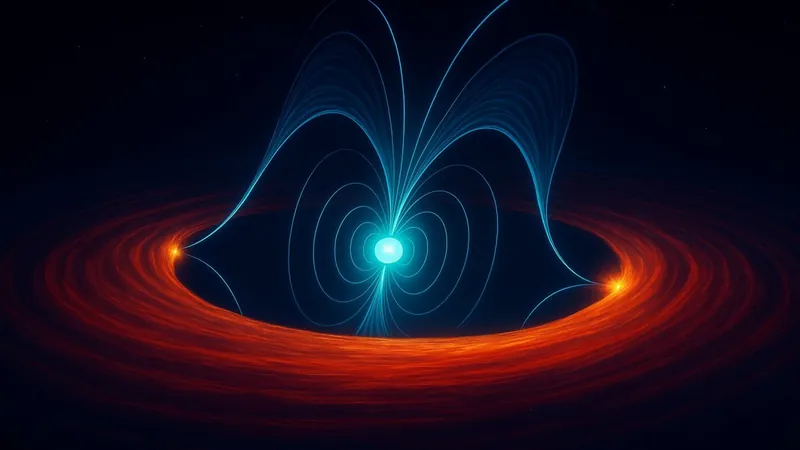
Unveiling the Mysteries of a Spinning Neutron Star: NASA's X-Ray Breakthrough
2025-07-16
Author: Yu
Astronomers Decode Pulsar Secrets 4,500 Light-Years Away
In a groundbreaking discovery, astronomers have uncovered that the dazzling X-ray emissions from a spinning neutron star, or pulsar, derive chiefly from its fierce particle winds rather than the material it siphons off its partner star.
Meet PSR J1023+0038: The Star That Spins 600 Times a Second
The pulsar under examination, known as PSR J1023+0038 (J1023), resides in a unique binary system sitting 4,500 light-years from Earth. This cosmic duo features a dead star, spinning at a staggering 600 rotations per second, alongside a low-mass companion star that feeds it.
A Rare Gem: The Transitional Millisecond Pulsar
J1023 is classified as a millisecond pulsar but is particularly special—it shifts between an active phase, where it aggressively feasts on its companion, and a dormant state reminiscent of typical pulsars that emit detectable radio waves. Only three such transitional millisecond pulsars are known, making J1023 a treasure trove for scientific exploration.
Maria Cristina Baglio, the lead researcher from the National Institute for Astrophysics (INAF), elaborates, "These transitional millisecond pulsars act as cosmic laboratories, shedding light on the evolution of neutron stars in binary systems."
The Cosmic Dance of Accretion and Radiation
Interestingly, the material J1023 strips away from its companion star does not plummet directly to its surface. Instead, it morphs into a swirling accretion disk—a flattened cloud astonishingly teeming with energy. This disk, as it revolves around the pulsar, emits formidable radiation spanning various electromagnetic wavelengths.
NASA's IXPE: A Powerful Tool for Astrophysical Insights
Utilizing NASA's Imaging X-ray Polarimetry Explorer (IXPE), the European Southern Observatory's Very Large Telescope (VLT) in Chile, and the Karl G. Jansky Very Large Array (VLA) in New Mexico, researchers completed a comprehensive survey of this binary X-ray source across multiple electromagnetic bands.
During their observations, they discovered that J1023 was in a low-luminosity active phase, showcasing rapid fluctuations in X-ray brightness, according to Baglio.
Record Polarization: A Cosmic First!
A significant highlight was IXPE's detection of 12% X-ray polarization from J1023—the highest ever recorded from a binary star system. In stark contrast, radio waves and optical emissions showed lower polarizations at 2% and 1%, respectively. However, the intriguing alignment of optical polarization with X-ray polarization hints at a shared origin for both.
Confirming Once-Imagined Theories
These findings validate a long-held theory positing that the polarized emissions from such binary systems arise from pulsar winds colliding with the surrounding accretion disk material. This insight cultivates a deeper understanding of what drives pulsars, and the expertise of IXPE was pivotal in achieving this breakthrough.
Alessandro Di Marco, another INAF researcher involved in the study, emphasized the challenge of this observation. "The IXPE's sensitivity enabled us to detect and measure this remarkable alignment, transforming theoretical models into practical observations across different wavelengths."
A New Dawn for Astrophysics
As discoveries like this emerge from the cosmos, they promise a brighter future for astrophysical research, unlocking the secrets of pulsars and reshaping our understanding of the universe.


 Brasil (PT)
Brasil (PT)
 Canada (EN)
Canada (EN)
 Chile (ES)
Chile (ES)
 Česko (CS)
Česko (CS)
 대한민국 (KO)
대한민국 (KO)
 España (ES)
España (ES)
 France (FR)
France (FR)
 Hong Kong (EN)
Hong Kong (EN)
 Italia (IT)
Italia (IT)
 日本 (JA)
日本 (JA)
 Magyarország (HU)
Magyarország (HU)
 Norge (NO)
Norge (NO)
 Polska (PL)
Polska (PL)
 Schweiz (DE)
Schweiz (DE)
 Singapore (EN)
Singapore (EN)
 Sverige (SV)
Sverige (SV)
 Suomi (FI)
Suomi (FI)
 Türkiye (TR)
Türkiye (TR)
 الإمارات العربية المتحدة (AR)
الإمارات العربية المتحدة (AR)